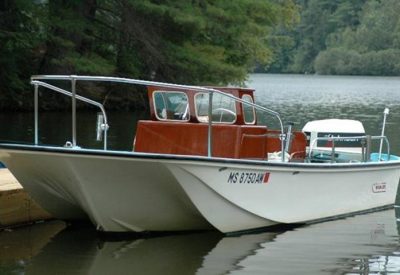by Mike Buss, Virginia Coastal Fly Anglers
This month let’s talk about watercraft. You know, the things you wish you were on when you are standing on the shore or beach and feeding fish are blitzing about 20 to 30 feet beyond your longest casts of the day! We are talking boats, canoes, kayaks, jon boats, pontoon boats, drift boats, and float tubes to name just a few.
You don’t want to spend your whole budget on a watercraft. If you do some looking you should be able to find something that will fit your budget. I recently purchased a 1968 Boston Whaler Sakonnet with a 70 HP motor and trailer for $2000. I had to travel all the way out to Texas to get it, but it fits my needs here in Tidewater, perfectly. It needed some work to get it ready for the water and I’ve already spent about what I paid for it in repairs and upgrades. What was that old saying that a boat was an open pit that you threw money into!
After cost, the next thing to consider is what you will be fishing for and where. If you will be fishing freshwater ponds I would highly recommend a float tube. The cost for one of these is around $150 and it will allow you to get into the water and get up close and personal with the fish. A canoe, jon boat, or kayak would also work well in these waters but will cost a little more.
If you are fishing larger lakes, you are going to need to be in a bigger boat. However, if you’re fishing close to shore in a bigger lake and don’t need to travel long distances then you can go with the same watercraft that would work in a pond. Just remember, paddling long distances into the wind is not easy. The wind always blows, and if you are not going into the wind when you are going out, you will probably be going into it on the way back in.
Kayaks seem to be all the rage these days and I see them everywhere, even out in the ocean, and I can understand why. They are inexpensive when compared to a boat, relatively easy to transport, and they are fun to fish from. Plus, kayak clubs seem to have sprung up everywhere and you can usually find someone to help you get started in one of these clubs.
After settling on the type of watercraft you want, the next thing to determine is what to outfit it with. It goes without saying that you should be wearing a life jacket for your safety. In addition, I recommend a depth finder and GPS. I would almost consider these to be critical to your success. There are even depth finders and GPS units that can be fitted onto a float tube. I have had such a set up for a number of years and it has really worked well for me in small ponds.
You should also have a signaling device to attract attention if you get into trouble or need to alert someone to your presence. I always carry a small whistle with me for this purpose. The Coast Guard requires certain items to be carried on board all watercraft and these vary with the type of watercraft, so you should check the Coast Guard regulations for the watercraft you will be using.
And, of course, you need to have room for your fishing gear. Be sure to make sure the watercraft you select has enough room to store your essential fishing equipment. Less is more when considering what to take with you. Most of the time you will be using the same things over and over and these should make up your essential set of fishing gear.
